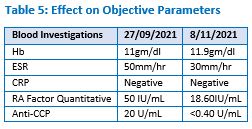Successful management and withdrawal of conventional medicine in Amavata patient (Seropositive Rheumatoid Arthritis) with an Ayurvedic intervention: A Case Report
Withdrawal of conventional medication by Ayurvedic management in Amavata (rheumatoid arthritis)
Keywords:
Amavata, Ama, Rheumatoid Arthritis, NSAIDs, DMARDs, Case ReportAbstract
Amavata (~Rheumatoid arthritis) is the most common condition among chronic inflammatory joint diseases. It occurs due to impairment of Agni (digestive fire), formation of Ama (bio-toxin) and vitiation of Vata Dosha. The produced Ama is carried by the aggravated Vata which gets deposited in the Shleshmasthana (Asthi - sandhi) and produces “Amavata”. The clinical features of Amavata are identical to Rheumatoid arthritis. In Conventional medicines NSAIDs, DMARDs, JAK inhibitors and corticosteroids plays a major role in the treatment of this condition; but they have serious adverse effects and have limitations for long-term therapy. Conventional drugs only provide temporary control to the pain but the possibility of further damage to joints remains the same because the root cause of the disorder remains unattended. This issue increases the urge to research the new possibilities of drugs that have predictable efficacy and a low toxic profile in this debilitating disorder. Ayurveda focuses on treating the root cause and breakdown of pathogenesis with the help of modalities like Langhana, Swedana, and use of drugs having Tikta, Katu Rasa and Deepana property, Virechana, Snehapana and Vasti. These procedures help in Amapachana, Vatashamana, and Strotoshodhana and have lesser side effects. Present case study was done on the female patient of Amavata in which the successful withdrawal of the DMARDs and NSAIDs were done with the help of Ayurvedic medicine.
Downloads
References
Dr. Santosh Kamble, Dr. Prakash Mane, Dr. Jondhale, P.B., Dr. Rohani, S.G. and Dr. Shende Krushnadev Laxman “A Clinical Evaluation of Alambushadi Churna (Y.R.) in Amavata”,International Journal of Current Research,7,(5), 17525-17529.
Dr. Ashish Premkumar Agrawal: A Case study on Amavata (Rheumatoid arthritis) ayurpub;II(5):646-651
Madhavakara, Madhavanidana, Vimala Madhudhara Teeka by Tripathi Brahmanand, Chaukhambha Surabharati Prakashana, Varanasi, ed. 2010, poorvardha, adhyaya 25, (Page.571-577).
Milind Y. Nadkar, API textbook of medicine, Rheumatology Chapter 7, Rheumatoid Arthritis, Association of Physicians of India, Mumbai, 8th edition, 2008, p:291
“An Ayurvedic approach to Amavata – A case study.” Namrata Shantaram Hulawale, Milind B.Nikumbh, Laxmi Barela
Churchill Livingstone, Davidson’s Principle and Practice of Medicine. 19th ed.: Elsevier Publication; 2002. (pp. 1002–7).
Dermis L Kasper et al. Harrison’s Principal of Internal Medicine. 16th Edition. Medical Publication Division; 2005. p.1974
Neha Lamba. A multidimensional Ayurvedic approach in management of Amavata: A case study. Int. J. Res. Ayurveda Pharm. 2017;8(Suppl 1):70-73 http://dx.doi.org/10.7897/2277- 4343.08142
Chakrapani Datta. Chakradatta commentary by Indradev Tripathi. Amavatarogadhikara 25/31-36. Varanasi: Chaukhamba Sanskrit Sansthan; 2010. (Pg. 167-168).
Mishra S N, editor. Bhaisajya Ratnavali of Kaviraj Govind Das Sen, Ghrahanirogadhikara: Chapter 8, Verse 26-27. Varanasi: Chaukhamba Surbharati Prakashan; 2019; 258.
Mishra S N, editor. Bhaisajya Ratnavali of Kaviraj Govind Das Sen, Amavatarogadhikara: Chapter 29, Verse 46-49. Varanasi: Chaukhamba Surbharati Prakashan; 2019; 599-600.
Tiwari P. Antimicrobial Activity of Amritarishta Prepared by Traditional and Modern Methods. Asian Journal of Pharmaceutical Research. 2014;4(2):114-6.
Bhattarai A, Kumawot G, Mangal G. Intervention of Amavata (Rheumatoid Arthritis) Through Multimodal Ayurveda Approach: A Case Study.
Mishra S N, editor. Bhaisajya Ratnavali of Kaviraj Govind Das Sen, Amavatarogadhikara: Chapter 29, Verse 185-190. Varanasi: Chaukhamba Surbharati Prakashan; 2019; 610.
Mishra S N, editor. Bhaisajya Ratnavali of Kaviraj Govind Das Sen, Jwaradhikara: Chapter 5, Verse 233-235. Varanasi: Chaukhamba Surbharati Prakashan; 2019; 105.
Dr. Brahmanand Tripathi, editor. Sarngadhara Samhita of Sarngadharacarya, Madhyam Khanada, Churna Kalpana: Chapter 6, Verse 115-119. Varanasi: Chaukhamba Surbharati Prakashan; 2016; 125.
Pandey SA, Joshi NP, Pandya DM. Clinical efficacy of Shiva Guggulu and Simhanada Guggulu in Amavata (rheumatoid arthritis). Ayu. 2012 Apr;33(2):247.
Kaneria M, Sharma G, Wadekar R, Pereira M, Naik SR. Evaluation of Antiarthritic activity of yograj guggulu formulation in fruends adjuvant induced poly arthritic rat model. Indian Drugs 2014;51:2;41-53.
Ram HA, Sriwastava NK, Makhija IK, Shreedhara CS. Anti-inflammatory activity of Ajmodadi Churna extract against acute inflammation in rats. Journal of Ayurveda and Integrative Medicine. 2012 Jan;3(1):33.
Kadwalia G, Sood P, Guleria P. Chandraprabha vati in mutrakrichhra-A review. World J Pharm Res. 2018 Feb 21;7:311-22.
Singh N, Bhalla M, de Jager P, Gilca M. An overview on ashwagandha: a Rasayana (rejuvenator) of Ayurveda. African Journal of Traditional, Complementary and Alternative Medicines. 2011;8(5S).















